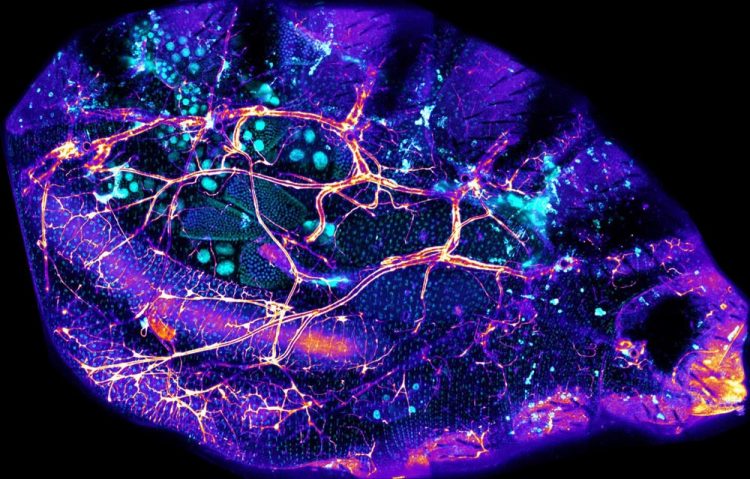What can you learn by peering into a fruit fly's gut? It turns out a lot!

Bellymount allows researchers to peer into the live tissue of the fruit fly gut and other visceral organs in real time. It provides researchers with massive amounts of time-series imaging data, which is revolutionary in the biological sciences. Image is courtesy of Leslie Koyama and Lucy O'Brien.
They say a picture is worth 1,000 words. But what about a real-time window into the complexity of the gastrointestinal system?
A new research tool allowed biologists to watch in real time the cell renewal process that keeps gut tissue healthy, as well as the interactions between bacterial species that make up the microbiome. Their work, led by Lucy O'Brien and KC Huang of Stanford University and Carnegie's Will Ludington, was recently published by PLOS Biology.
The system, dubbed Bellymount, allowed researchers to peer into the live tissue of the fruit fly gut and better understand the many complex, overlapping processes occurring there.
O'Brien developed it to understand how stem cells in the gastrointestinal system drive the tissue renewal process that gets rid of sick cells and replaces them with new, healthy ones. When this process is disrupted, it has an aging effect. Understanding it could drive improvements in precision medicine and guide the development of regenerative therapies.
“Before now, no one has ever watched how gut renewal progresses because it occurs over many days and happens deep inside the body,” O'Brien explained.
Using Bellymount, the researchers were able to watch stem cells coordinating during the organ renewal process and discovered that the rate at which individual stem cells generate adult replacement cells varies greatly. No one had seen the gut renewal process play out in real time before this.
“Each stem cell seems to work at its own pace,” said lead author Leslie Koyama of Stanford.
Beyond the gut, Bellymount will allows researchers to spy on other visceral organs in fruit flies, watching how organs communicate with each other during whole-body processes.
It also enabled Ludington, who specializes in understanding the interactions between species in the microbiome, to better understand how the gut's bacteria contribute to many of its functions by watching them unfold.
“Bellymount let us observe the dynamic interactions of gut bacterial populations with the host for the first time,” he said.
They found that there are regional differences in microbiome stability that actually mimic the regionality of the stem cell activity. Some parts of the microbiome are continuously turned over and others are more like a reservoir.
“It makes you wonder how gut stem cells and gut bacteria are talking to each other and possibly coordinating their actions,” said co-author K.C. Huang, also of Stanford. “Now we have the power to actually eavesdrop on their conversations.”
Because Bellymount allows investigators to peek at the activity of all of the flies' visceral organs, this crosstalk can be monitored across tissues and inform how they understand whole-body processes, such as immune surveillance, reproduction, aging, and cancer.
###
The Carnegie Institution for Science is a private, nonprofit organization headquartered in Washington, D.C., with six research departments throughout the U.S. Since its founding in 1902, the Carnegie Institution has been a pioneering force in basic scientific research. Carnegie scientists are leaders in plant biology, developmental biology, astronomy, materials science, global ecology, and Earth and planetary science.
Media Contact
More Information:
http://dx.doi.org/10.1371/journal.pbio.3000567All latest news from the category: Life Sciences and Chemistry
Articles and reports from the Life Sciences and chemistry area deal with applied and basic research into modern biology, chemistry and human medicine.
Valuable information can be found on a range of life sciences fields including bacteriology, biochemistry, bionics, bioinformatics, biophysics, biotechnology, genetics, geobotany, human biology, marine biology, microbiology, molecular biology, cellular biology, zoology, bioinorganic chemistry, microchemistry and environmental chemistry.
Newest articles

Properties of new materials for microchips
… can now be measured well. Reseachers of Delft University of Technology demonstrated measuring performance properties of ultrathin silicon membranes. Making ever smaller and more powerful chips requires new ultrathin…

Floating solar’s potential
… to support sustainable development by addressing climate, water, and energy goals holistically. A new study published this week in Nature Energy raises the potential for floating solar photovoltaics (FPV)…

Skyrmions move at record speeds
… a step towards the computing of the future. An international research team led by scientists from the CNRS1 has discovered that the magnetic nanobubbles2 known as skyrmions can be…





















